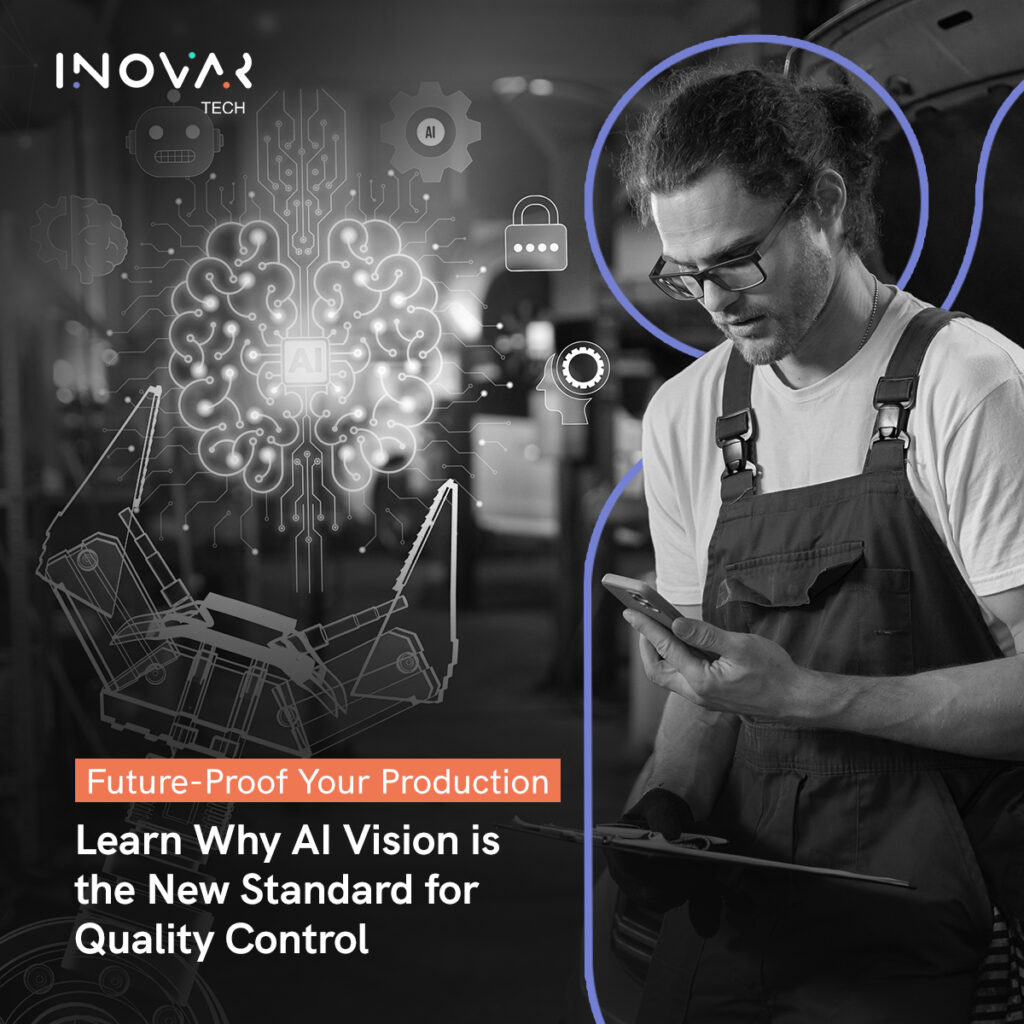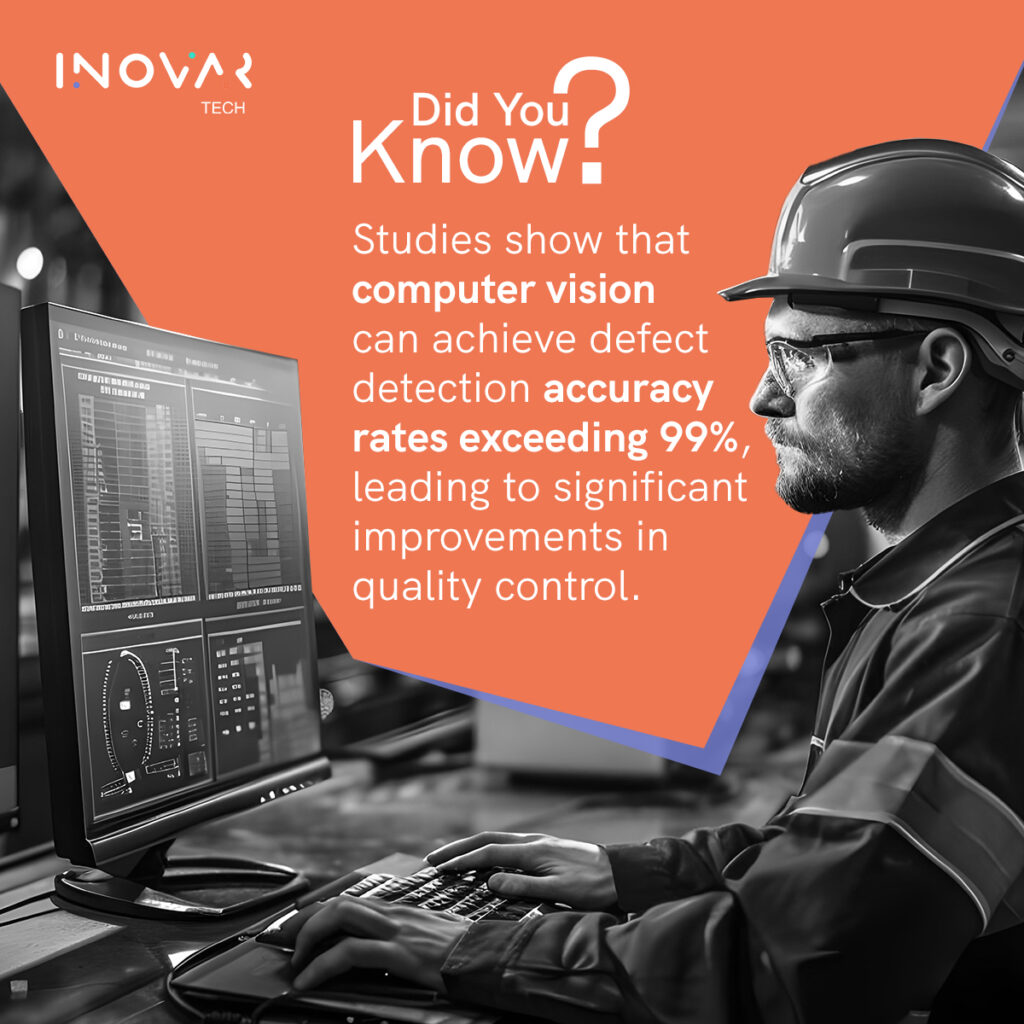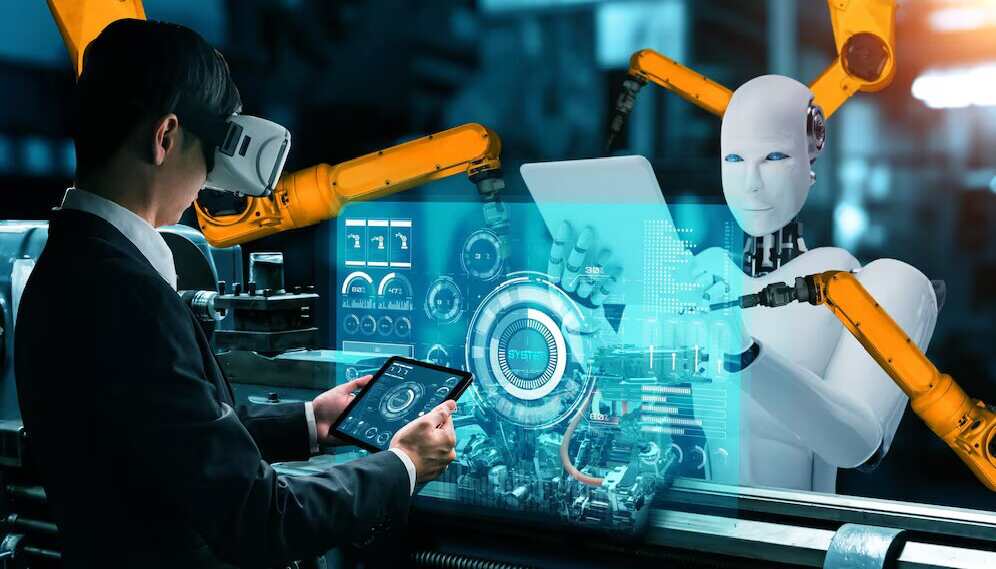Tag: Artificial Intelligence
Quality is a critical requirement in the manufacturing industry. High-quality products lead to several far-reaching benefits, including a stronger market position, competitive advantage, customer loyalty, and increased revenues. However, manually conducting quality control checks or relying on security cameras to monitor worker activity is time-consuming and cumbersome.
Increasing consumer focus on product quality and safety and evolving regulations demand a more fool-proof and innovative way to transform quality.
As quality becomes a differentiating factor across the manufacturing production line, there is an urgent and widespread need to move beyond traditional quality control techniques. Learn how computer vision fits the bill!

The Limitations Of Traditional Quality Control Approaches
Traditional approaches to manufacturing quality control often fall short of meeting the complex needs of modern-day quality requirements. With regulations constantly evolving, companies in the manufacturing sector are under immense pressure to ensure their products meet the necessary quality and safety standards.
Any deviation from the expected level of quality can lead to far-reaching consequences, impacting product quality, diluting business reputation, and resulting in hefty fines by regulatory bodies. Let’s look at the are some of the drawbacks of traditional approaches to quality control:
- Inconsistent results: Manually conducting quality checks can lead to inconsistent results. Since different teams might use different approaches and tools for quality control, it can lead to variability.
- Exhaustion: Quality teams that rely on manual approaches to quality control often experience fatigue and exhaustion in the long run.
- Error-prone: Using traditional tools and manual efforts is also known to result in errors and subjective quality assessments.
- Time-consuming: Manual approaches to quality control are also extremely time-consuming, affecting overall production speed and efficiency.
- Reactive: Manually viewing security camera footage for assessing worker behavior only provides evidence via stored tapes and cannot prevent quality issues from happening.
The Business Case for Computer Vision
Computer vision technology helps overcome the inherent challenges of manual quality control approaches. Underpinned by advanced automation, Artificial Intelligence (AI), and deep learning capabilities, computer vision significantly enhances the capabilities of traditional quality control systems. Through real-time monitoring and analysis of manufacturing processes, modern AI vision quality inspection copilots can help prevent quality incidents and pave the way for intelligent surveillance.
Today, these AI copilots are revolutionizing quality control, utilizing a multitude of algorithms for quality inspection results. Systems with computer vision technology can interpret and analyze video feeds in real time and offer unparalleled insights for proactive quality control measures.

Here are the top five reasons why businesses should invest in computer vision systems for intelligent surveillance:
1. Zero Human Error: AI vision quality inspection copilots guarantee 100% precision in quality inspection processes without human intervention. Easy to deploy, these AI models can provide accurate results with just a few images and data sets, improving your quality parameters in days rather than months.

2. Proactive Quality Inspection: In manufacturing quality control, computer vision systems use camera images and run algorithms to extract relevant insights. For instance, they can assess features like color, size, and shape of manufactured components and spot any deviations from the desired quality standards.

3. Behavior Analysis: Computer vision technology results in smarter, more efficient monitoring of production processes. By harnessing the power of real-time analytics, businesses can process and analyze vast amounts of visual data and enable rapid and accurate decision-making. For instance, computer vision algorithms can be trained to recognize and analyze human behavior patterns. This can help detect unsafe practices and trigger suitable responses.

4. Anomaly Detection: Computer vision technology greatly benefits in detecting anomalies in production processes. Utilizing deep learning architectures, it can inspect raw materials and finished goods for defects and ensure the highest level of quality. Unlike manual spotting, which is tiring and cumbersome, computer vision allows fast and accurate detection of unwanted or threatening objects. For instance, computer vision-enabled surveillance systems can scan raw materials to identify incorrect dimensions and prevent them from being used further in manufacturing.

5. Video Summarization: Manufacturers can also automate video summarization with computer vision technology. Instead of watching security camera footage in its entirety, they can quickly and comprehensively understand red flags. For instance, intelligent surveillance systems can generate a synopsis of captured footage, directing quality inspectors to the exact incidence of error.

6. Proactive Alerting: Computer vision systems can also trigger alarms whenever a spurious activity occurs. For example, the technology can inspect finished goods to identify damaged ones and alert staff to take them off the delivery line.

Revolutionize Quality Control with Computer Vision
Computer vision is a pivotal component of modern-day quality control, with applications extending far beyond traditional surveillance. Replacing traditional quality control with intelligent AI capabilities can perform a range of sophisticated analytics and contribute significantly to higher levels of security and quality.
From behavioral analysis to anomaly detection, video summarization, and proactive alerts, AI vision systems enable smarter, more responsive quality monitoring and control.
Looking to revolutionize quality control checks into a pillar of reliability and precision? Explore InovarTech’s AI copilot, VisionGuard, and learn how it allows flawless quality control via zero human error and total AI precision.
Customer service in the B2C domain has gone through a “rollercoaster” wave since the end of the global pandemic. 72% of customers plan to remain loyal to brands that provide fast and exceptional customer service. 78% of customer service agents find it challenging to balance between speed and quality of service. This has increased from just 63% in 2020. Rising service-related work pressure has increased labor turnover by 19% in customer servicing teams.
According to this McKinsey article, two-thirds of millennials expect to receive real-time customer service. Three-fourths expect a consistent cross-channel experience. It comes as no surprise that more companies are turning to AI technology to scale their customer service to the next level.
In this blog, let’s learn more about how AI can be leveraged to deliver highly personalized customer service even at scale.
What is AI-powered Customer Service?
AI-powered customer service is all about leveraging AI technology to scale every aspect of customer’s interactions with the brand. Depending on business requirements, customer support teams can utilize this technology in different ways.
For instance, AI-enabled chatbots can provide immediate responses to customer queries, instead of making them wait for a human response. According to HubSpot, 90% of customers rate it important to receive a prompt response (within 10 minutes) from service agents.
How does this benefit customer-focused companies? Besides increasing engagement, AI-enabled customer service tools can provide cross-selling and upselling opportunities. Besides, it works to reduce manual work, thus also the operational cost of customer support.
A Zendesk CX Trends report also found that customers are now comfortable with companies collecting their personal information. This enables companies to provide a personalized experience to their customers.
In 2024, 80% of customers have had a positive experience while interacting with an AI-powered customer service tool.
How does AI-powered customer service deliver a personalized experience at scale? Here are some ways:
- Leveraging customer data and insights
76% of customers want companies to leverage their data to provide a personalized experience,
With AI technology, customer support teams can have a more personalized interaction with customers. This requires them to completely understand the customer profile. On initiating this interaction, AI-powered tools provide customer service agents to understand their:
- Customer intent
- Preferred language
- Current sentiment
In turn, this is effective at improving the agent’s productivity and efficiency in addressing the customer query or problem.
- Self-servicing capabilities
In the wake of the COVID-19 pandemic, more customers started to migrate to self-service digital channels as their “first point of interaction.” 81% of customers try to take care of their issues before contacting a live agent.
AI-powered self-servicing tools leverage their ability to process natural language to understand customer queries and provide appropriate solutions. Using resources like knowledge bases and FAQs, AI in customer service can quickly find answers to customer queries – without having to wait for human intervention.
To assist customers, self-service portals can help them find their solutions, thus saving both time and effort.
- Predictive analytics
AI-enabled predictive analytics tools can drive more “precise and scalable” personalization. Using predictive analytics, companies can utilize customer data to anticipate their needs and behavior patterns. These insights allow them to:
- Address their customer queries proactively.
- Allocate optimum resources.
- Personalize the customer interaction.
By integrating predictive analytics into customer service, companies can continuously improve prediction models and stay “tuned” to customer preferences. To improve their prediction efficiencies, AI-powered models analyze various data sources including:
- Customer interactions
- Customer feedback and surveys
- Transactional data and buying history
- Social media
- Sentiment analysis
With its natural language processing or NLP capability, AI tools in customer service can easily understand and interpret human language. This can help this tool understand human sentiment and take appropriate actions. Besides this, AI-powered sentiment analysis tools can gauge the customer’s brand perception from:
- Customer feedback.
- Product (or service) reviews.
- Social media posts.
How does sentiment analysis improve customer service? Companies can use these AI-driven insights to personalize their customer experience and respond appropriately to their concerns. Besides, by using machine learning algorithms, sentiment analysis tools can detect “fake” reviews with 85% accuracy.
- Chatbots
According to the Zendesk CX Trends report, companies using AI in customer service could resolve issues 30% faster. AI-powered chatbots are crucial for providing faster responses and answers. Beyond simply answering customer queries, chatbots are delivering a personalized experience by:
- Greeting customers in a personalized tone.
- Guiding them through relevant business processes.
- Routing more complex queries to the right customer support agent.
Effectively, an AI-enabled chatbot acts as a “virtual buddy” that understands individual customer’s needs and preferences.
- Hyper-personalization
By combining AI technology with data and analytics, companies can now “hyper-personalize” their customer service. According to this Deloitte report, companies can hyper-personalize the entire customer journey including:
- Attracting customers with targeted marketing messages.
- Providing dynamic pricing to individual customers.
- Providing personalized services after the purchase.
Through hyper-personalization, companies can customize their products and customer services based on their data, preferences, and behaviors. Their real challenge lies in how to scale personalization without “overwhelming” the customer. Using AI technology, they can deliver personalized content that is in tune with changing customer behaviors and preferences.
Conclusion
Customer engagement is a focus point for companies of all sizes worldwide. As customers expect more personalized experiences, AI-powered customer service is the answer to keeping them engaged and loyal.
At InovarTech, we help you leverage AI technology for your business benefits. Our AI-enabled data analytics can scale your business to the next level. Get in touch with us to know more!
Businesses across sectors have long been leveraging technologies like automation to enhance workforce productivity, improve system efficiency, and drive better business results. Yet, when it comes to accelerating the decision-making process, many hit a roadblock. Given the sheer pace of change, making quick and effective decisions requires organizations to look beyond automation and open doors to the world of intelligent automation.
Read on to explore the need for and benefits of intelligent automation and the steps you must take to orchestrate a seamless transition to intelligent automation.
The Need for Intelligent Automation
Intelligent automation, also called cognitive automation, leverages automation technologies such as business process management (BPM) and robotic process automation (RPA), along with artificial intelligence (AI), to accelerate and scale decision-making across the organization. By automating repetitive and time-consuming tasks, rapidly processing information, and quickly identifying patterns in data, human resources can focus more time on strategic tasks at hand.
Through automated analysis of large volumes of data, intelligent automation simplifies processes, leading to:
- Improved productivity: Intelligent automation reduces the cognitive load on humans, leading to better productivity and quicker decision-making. For instance, manufacturing firms facing challenges in managing purchase requisitions can leverage intelligent automation to automate the approval process. This can help minimize the number of people required for the process while also automating the tracking of different requests – thus improving productivity and accelerating operations.
- Continuous improvement: With intelligent automation, humans can cut down on the many steps needed to accomplish certain tasks. Completing mundane and error-prone tasks for people and providing valuable insights to decision-makers, can help kick-start a continuous improvement cycle. For example, while onboarding new customers, teams can get intelligent insights on how they can speed up the onboarding process, thereby reducing the turnaround time. For example, healthcare organizations struggling to conduct health assessments and maintain accurate records of patients can embrace intelligent automation to expedite manual tasks, eliminate multiple steps involved in data management, and generate comprehensive medical reports.
- Reduced errors: Manually going through forms and entering data into systems is a highly time-consuming and error-prone process. Through the intelligent automation of data entry efforts that are most frequently erroneous, teams can prevent miscalculations and ensure the efficiency of processes. For example, HR teams dealing with goal management can use intelligent automation to overcome errors associated with manual goal-setting and tracking, address inconsistencies in operations, and receive automated notifications and reminders for goal updates.
- Optimized costs: Intelligent automation offers the ability to deal with exceptions and anomalies that might emerge in day-to-day operations – thus minimizing the impact and cost of damage. For instance, large MNCs can exploit the capabilities of intelligent automation to streamline license and compliance management, thus improving compliance with evolving regulations and curtailing the costs of non-compliance.
- Better customer satisfaction: Intelligent automation can also allow for better customer satisfaction. For example, suppliers dealing with assets via work order management can use intelligent automation to streamline workflows to reduce errors and manage work orders from creation to completion – leading to better customer satisfaction.
- Easier scalability: Using intelligent automation, manufacturers can more effectively predict and adjust production to respond to changes in supply and demand. For example, startups looking to enable peer-to-peer lending can use intelligent automation to automate the document validation process, pick the right investors based on their risk appetite, and seamlessly onboard more vendors as the business grows.
Roadblocks to Adopting Intelligent Automation
Despite the disruptive benefits of intelligent automation, enterprise-wide adoption comes with several challenges:
- Privacy concerns: One of the biggest roadblocks to intelligent automation adoption is around data privacy. Since intelligent automation algorithms often collect and analyze personal, financial, and demographic data, they raise several privacy concerns among individuals and regulatory bodies.
- Data quality issues: Intelligent automation solutions need highly accurate, consistent, and constantly updated data to work their charm. Poor data quality often dilutes intelligent automation efforts while leading to inaccurate and unfavorable results.
- Poor data governance: The lack of proper data governance also impedes intelligent automation while raising several ethical concerns. In the absence of a robust strategy, intelligent automation systems can act on inaccurate or biased data, snowballing to unfavorable and erroneous outcomes.
- Lack of skillsets: Successfully transitioning to intelligent automation requires the knowledge and efforts of skilled resources. Lack of appropriate talent often makes it difficult to maximize the ROI of intelligent automation.
- Workforce resistance: The adoption of intelligent automation is also often met with widespread employee resistance. The fear that AI technologies might displace human workers leads to limited acceptance and hence, restricted benefits.
- Change management: Bringing intelligent automation into the organization demands several changes to be made to existing processes. This requires strong change management policies to make changes to critical systems, maintain employee experiences, and minimize disruptions to ongoing operations,
Best Practices for Success
If you want to successfully transition from simple automation to intelligent automation, here are some things to keep in mind:
- Have clarity on intelligent automation objectives: Intelligent automation isn’t just about implementing a system and expecting transformative results. You must first have clarity on the goals you are trying to achieve through implementation. It can be anything from improving productivity to reducing errors, lowering costs, or more.
- Build a robust strategy: Once you know the goals you want to achieve, you must build your intelligent automation strategy. Make sure to link your strategy with larger business goals and get the necessary leadership support and funding for your project. Build a robust implementation roadmap and document important milestones, critical challenges, and expected results.
- Invest in the right skill sets: Investing in the right skill sets is a critical aspect of intelligent automation. You can either upskill your existing workforce on technologies like AI, machine learning, natural language processing, computer vision, etc., hire new resources with these skills, or engage with qualified vendors who can provide access to required talent on demand.
- Eliminate barriers to scalability: Eliminating roadblocks and inefficiencies that eat into profits is extremely important for intelligent automation success. Such elimination can help your intelligent automation project scale more efficiently.
- Reengineer existing processes: Integrating intelligent automation into the existing technology landscape requires sufficient reengineering and revamping of processes. Low-code and no-code solutions are great options to tweak current tools and processes or create new ones, thus ensuring a strong foundation for successful intelligent automation.
- Prepare and cleanse data: Intelligent automation systems need to be fed accurate and clean data, so they can make the right decisions. To ensure this, it is important to identify the most valuable data sources, aggregate, clean, and analyze various types of information, and feed them into automation models for improved analytics and maximum effectiveness.
- Ensure data governance: For intelligent automation systems to drive accurate, ethical, and unbiased decisions, a proper data governance strategy is extremely essential. Make sure to build a high-level governance plan and define goals to improve data quality, guide resource allocation, and enable greater return on investment.
- Train and educate: If you want to ensure your intelligent automation systems are used to their maximum efficiency, you must train and educate your employees. Training employees on how best to utilize these systems and addressing their concerns periodically is sure to enable long-term business benefits.
As artificial intelligence continues to seep across the business world, its significance in the realm of automation cannot be understated. Automation technologies like BPA and RPA, when combined with the power of AI, open doors to several transformative benefits. From improved productivity to quicker and more accurate decision-making, reduced errors to minimized costs, better customer experience to strong brand reputation and more – intelligent automation is the only way forward.
Create long-term business value and ensure symphony with InovarTech. Contact us to know more!